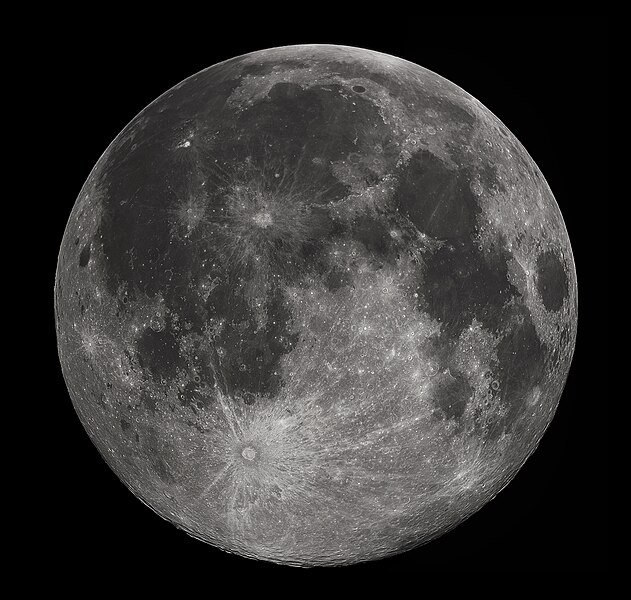
Full Moon photograph taken 10-22-2010 from Madison, Alabama, USA. Photographed with a Celestron 9.25 Schmidt-Cassegrain telescope. (Image Source: Wikipedia.org )
Published: Wednesday, June 19, 2013 - 17:04
in Astronomy & Space
Discovering molecular hydrogen on the moon was a surprise result from NASA's Lunar Crater Observation Sensing Satellite (LCROSS) mission, which crash-landed the LCROSS satellite's spent Centaur rocket at 5,600 miles per hour into the Cabeus crater in the permanently shadowed region of the moon. These regions have never been exposed to sunlight and have remained at temperatures near absolute zero for billions of years, thus preserving the pristine nature of the lunar soil, or regolith.
Instruments on board LCROSS trained on the resulting immense debris plume detected water vapor and water ice, the mission's hoped-for quarry, while LRO, already in orbit around the moon, saw molecular hydrogen -- a surprise.
"LRO's Lyman Alpha Mapping Project, or LAMP, detected the signature of molecular hydrogen, which was unexpected and unexplained," says Jordan.
More - Link >>> http://esciencenews.com/articles/2013/06/19/metamorphosis.moons.water.ice.explained
Sources: University of New Hampshire, e! Science News.
Want to receive SpaceWatchtower blog posts daily in your inbox ?
Send request to < spacewatchtower@planetarium.cc >.
gaw
Glenn A. Walsh, Project Director,
Friends of the Zeiss < http://friendsofthezeiss.org >
Electronic Mail - < gawalsh@planetarium.cc >
About the Editor/Author: < http://buhlplanetarium.tripod.com/#GAW >
SPACE & SCIENCE NEWS, ASTRONOMICAL CALENDAR:
< http://buhlplanetarium.tripod.
Twitter: < https://twitter.com/spacewatchtower >
Facebook: < http://www.facebook.com/pages/
Blog: < http://spacewatchtower.
Author of History Web Sites on the Internet --
* Buhl Planetarium, Pittsburgh:
< http://www.planetarium.
* Adler Planetarium, Chicago:
< http://adlerplanetarium.
* Astronomer, Educator, Optician John A. Brashear:
< http://johnbrashear.tripod.com >
* Andrew Carnegie & Carnegie Libraries:
< http://www.andrewcarnegie.
* Civil War Museum of Andrew Carnegie Free Library:
< http://garespypost.tripod.com >
* Duquesne Incline cable-car railway, Pittsburgh:
< http://inclinedplane.tripod.
* Public Transit:
< http://andrewcarnegie2.tripod.
No comments:
Post a Comment